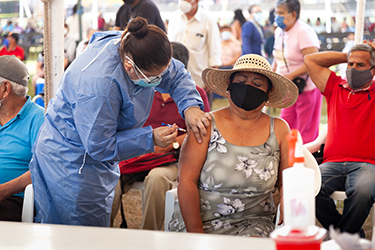Today’s National Public Health Week focus is on mental health. As the public health workforce continues to fight COVID-19 and protect the public, their mental health needs attention as well, says Julia Haskins, senior editorial associate at the de Beaumont Foundation. Haskins discusses the mental health crisis facing the governmental public health employees through the data-driven lens of the Public Health Workforce Interests and Needs Survey.
Burned out, facing harassment and operating in a politically charged environment, members of the public health workforce have suffered a major blow to their mental health and well-being throughout the COVID-19 pandemic. That’s a problem not just for employees, but also for the communities they serve, who rely on a strong public health workforce.
Data from the 2021 Public Health Workforce Interests and Needs Survey give proof of life to the challenges experienced by employees of state and local health departments. The latest version of PH WINS — the only nationally representative survey of the governmental public health workforce — point to high levels of stress, burnout and intent to leave among employees during the COVID-19 era. 
Among the most alarming findings from PH WINS 2021, more than half of governmental public health workers reported at least one symptom of PTSD, with one-quarter experiencing three or four symptoms. Almost one-third of respondents said they were considering leaving their organizations within the next year. Work overload/burnout and stress were among the top five reasons for leaving. In addition, 39% of those considering leaving said the pandemic influenced their motivation to leave.
“Public health has been underfunded for decades, but the pandemic has pushed the workforce to their limit,” said Brian C. Castrucci, DrPH, president and CEO of the de Beaumont Foundation, in a news release. “This is an underreported story that affects the health of communities across the country. These data show that the public health workforce is fast approaching a breaking point.”
This iteration of PH WINS is also the only survey of its kind and scale to be fielded during the COVID-19 pandemic, documenting candid perspectives from public health employees at the height of the crisis.
The strain on public health employees’ mental health at this time was captured in a qualitative study of insights from PH WINS 2021. According to the study, published in the Journal of Public Health Management and Practice, while public health employees expressed pride in their work and the mission of public health, their sense of accomplishment was coupled with burnout, stress, and feeling underappreciated.
“We have tried diligently to respond appropriately to COVID in our clinic, even with tireless hours and tears shed,” wrote one respondent to the 2021 PH WINS survey. “I cannot speak for the entire health department, but our clinic spearheaded the response and continues to do so with our heads held high.”
Another employee wrote that “it was great to be a part of something that was different from the usual and important, but it did wear on me. I did not take much time off and I still don't feel back to normal, but I have a light at the end of the tunnel that many don't, in that I can retire next year.”
Many public health workers who are not close to retirement age are looking to exit the workforce or have already made that leap. A study using PH WINS data that was published in Health Affairs sheds light on the exodus of public health employees that began before the pandemic: Nearly half of state and local public health employees left their organizations between 2017 and 2021. Among those with less than five years of experience at their organizations, 77% left. Among those under age 35, 74% left.
The loss of so many personnel, as well as their institutional knowledge and experience, poses dangers to community health and safety at a time when public health expertise is critical to responding to current and emerging threats. Should these trends continue, about 130,000 employees will have left their jobs by 2025 — that’s on top of the estimated 80,000 additional employees who are still needed to provide a minimum set of public health services in their communities.
“Our nation’s future depends on successfully rebuilding a robust and reinvigorated public health workforce,” said Howard K. Koh, MD, MPH, Harvey V. Fineberg Professor of the Practice of Public Health Leadership at the Harvard T.H. Chan School of Public Health and a study author, in a blog post announcing the data. “Our lives and livelihood literally depend on it.”
The slate of research and analysis produced through PH WINS shows that the toll of the pandemic on employees goes beyond their workplaces. When members of the workforce suffer, so too do their communities and the future of public health.
A graphic illustration of the findings is available on the de Beaumont Foundation website.
A health worker administers a COVID-19 vaccination to a person in 2021 at a pop-up center in the town of Tepoztlán in Morelos, Mexico. (Photo by MarsBars, courtesy iStockphoto)